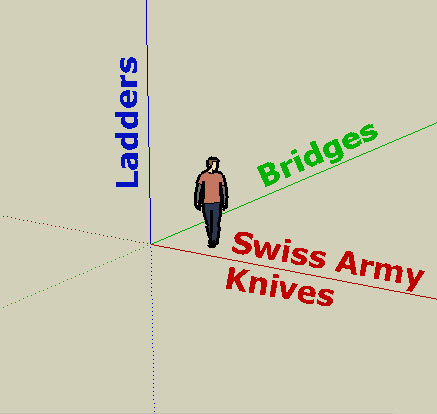
~ Ayn Rand

The beauty of my three ideas is they cover the entire universe of possible educational options. When the inevitable march of time brings change to the world of educational technology, my three ideas will serve as an ideal framework. New learning needs will demand Bridges to bring understanding from ignorance. New learning theories are the Ladders used to build understanding upon ignorance. And new learning technologies are tools in the Swiss Army Knife, which can be used as needed to support a Ladder as it stands upon a Bridge.
Just as the concept of horizontal and vertical markets help define economic and business strategy, my horizontal Bridges and vertical Ladders can help define educational strategy. For example, your audience and needs analysis might say your learners require a print-based Bridge, which uses the programmed instruction Ladder to bring them to enlightenment (Clark, 1999). You may then decide to expand the Bridge laterally (or make your Ladder rungs thicker) by using the podcast and wiki tools from your instructional Swiss Army Knife.

Perhaps most important, the three concepts are fairly easy to visualize. Some theories and tools may not fit the construct exactly, but as a common frame of reference, the taxonomy helps make many of them more accessible. Certainly looking at both the horizontal and vertical needs of any instructional or performance intervention will help narrow down the focus, which always does wonders in building a positive solution.
It may be possible for someone to mis-use the framework, but just like a pebble-bed reactor is self-dampening, the systematic design of instruction tends to correct itself. If there is any danger to future learners, it is at the hands of marginally prepared designers who have a mediocre passion for their trade. These are the people we must all watch for - and correct for. Even more important, we should take their recalcitrance as a challenge, working to bring them further across the bridges and up the ladders of Educational Technology. When I began this essay, I described how in my youth I failed to understand why people would ever strive for mediocrity. With my idealism colored by many more years of experience, it is still hard for me to understand.

Everyone watches the weather. Some days, the clouds are bright and puffy, other days they’re dark and rainy. Most people look at clouds in the same way their entire lives. For many years, clouds were just clouds. Then I became a helicopter pilot. I studied meteorology, and applied the lessons I learned in every possible environment on the planet. Once you’ve piloted an aircraft aloft, you will never look at clouds the same way, ever again. Now that the EDTEC program has borne me aloft, no performance problem or instructional intervention will look the same, ever again. My new insight is really what I’ll take away from San Diego. As in the future I bring others aloft, I’ll try to point out all the grandeur that can be found among the EDTEC clouds. The view from here is spectacular.
Clark, R (1999). Developing technical training. Silver Spring, MD: International Society for Performance Improvement.
Heinlein, R (1973). Time enough for love. New York: Ace Books.
Additional References can be found within the various Standards refections.
Influential Instructor: Peter C. Leeds
"Leeds" taught second year high school English. This was my first exposure to journaling. He had us recite poetry, and didn't mind I picked a song by Dire Straits. He was also my Cross Country coach junior and senior year. We wanted to start a juggling club, and he volunteered to be the advisor. He was also advising the yearbook and the photography club at the same time. His example showed me how walking many paths gives you a life much more rich. Peter Leeds was my first model of the human Swiss Army Knife.